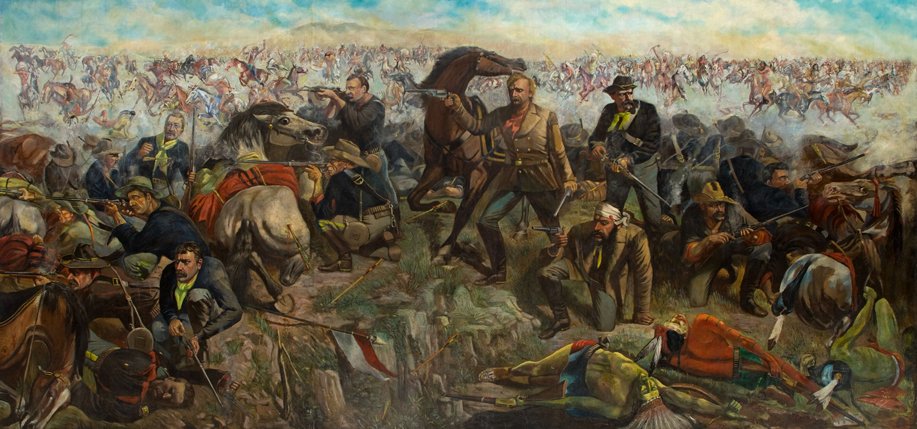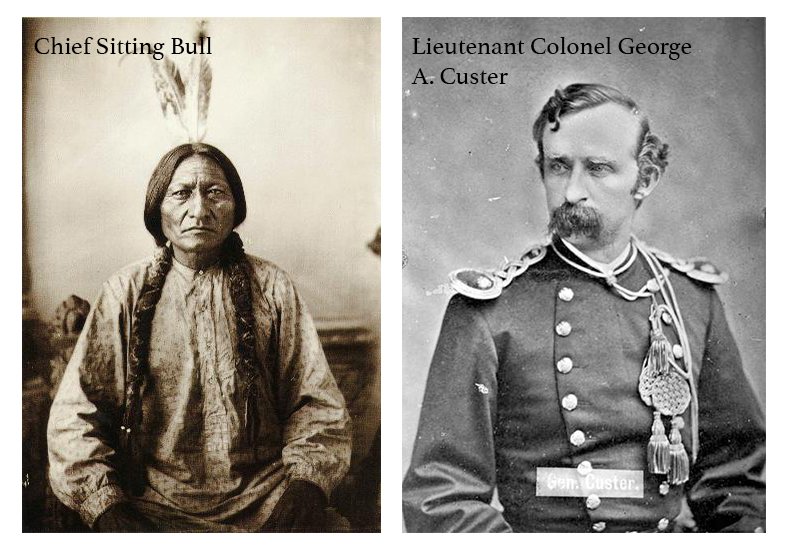
‘Custer’s Last Rally,’ painted by John Mulvany. Photo courtesy of the Kansas Historical Society.
On the morning of June 25, 1876, two great Native generals, Sitting Bull and Crazy Horse, prepared between 1,500 and 3,500 warriors for battle. Crazy Horse was an Oglala Lakota war chief. Sitting Bull of the Hunkpapa Lakota provided guidance and leadership.
The warriors of Crazy Horse’s army were from the Lakota, Dakota, Arikara, Northern Cheyenne, and Arapaho tribes. They had come together to form a unique alliance against US encroachment on their territories.

Two years earlier, Lt. Col. George A. Custer, a Civil War hero, and miner Horatio Ross had conducted an expedition in the Black Hills, which was Dakota territory. They found gold, setting up a showdown with the tribes.
Across the Little Bighorn River of southern Montana, Custer, by then in command of the 7th Cavalry Battalion, received word that Crazy Horse’s scouts were tracking him. Custer decided to act before the scouts could report his position to the Native army’s main force.
By the time he reached the Crow Reservation, Custer had made a key mistake, marching his 600 men beyond the reach of his reinforcements. Believing he had surprise on his side, he split his men into three groups of approximately 200 people each. He would attack with one force while sending the other two units on flanking maneuvers to surround the Native force. But Custer had seriously underestimated both the terrain and the size of the enemy force.

Crazy Horse saw Custer’s 200 men approaching and sent 3,000 warriors to engage him. Custer’s flanking units retreated almost immediately from the huge numbers of Northern Cheyenne driving them back. Of Custer’s three units, only his held its ground, dooming Custer and his men.
The 7th Cavalry Battalion was obliterated in less than an hour in one of the worst military defeats in US history. No US troops survived the engagement. Several of Custer’s close relatives were killed in the fighting, including his two brothers, a nephew, and his brother-in-law. Still, when news of the massacre reached the East, Custer was trumpeted as a hero.

Though several people claimed to have killed Custer, Cheyenne oral tradition credits Buffalo Calf Road Woman, who fought beside her husband at Little Bighorn, with the deed. According to Lakota Noon: The Indian Narrative of Custer’s Defeat, it’s unlikely any of the Native Americans knew who Custer was, let alone recognized him in the heat of battle.
According to Lakota history, the warriors stripped and mutilated the men after the encounter, “believing that the soul of a mutilated body would be forced to walk the earth for all eternity and could not ascend to heaven.” Custer’s body was stripped; however, it was inexplicably neither mutilated nor scalped.
The Battle of the Little Bighorn — known in Lakota lore as the Battle of the Greasy Grass — marked the end of the Lakota Wars and the last time Native Americans would form a warrior alliance of that magnitude. The Black Hills was ceded to the United States in 1877 after Crazy Horse surrendered at Fort Robinson, Nebraska, and the US government threatened the reservations with forced starvation.
Read Next: Roswell: Balloons and Dummies, but No Aliens

Lauren Coontz is a former staff writer for Coffee or Die Magazine. Beaches are preferred, but Lauren calls the Rocky Mountains of Utah home. You can usually find her in an art museum, at an archaeology site, or checking out local nightlife like drag shows and cocktail bars (gin is key). A student of history, Lauren is an Army veteran who worked all over the world and loves to travel to see the old stuff the history books only give a sentence to. She likes medium roast coffee and sometimes, like a sinner, adds sweet cream to it.
BRCC and Bad Moon Print Press team up for an exclusive, limited-edition T-shirt design!
BRCC partners with Team Room Design for an exclusive T-shirt release!
Thirty Seconds Out has partnered with BRCC for an exclusive shirt design invoking the God of Winter.
Lucas O'Hara of Grizzly Forge has teamed up with BRCC for a badass, exclusive Shirt Club T-shirt design featuring his most popular knife and tiomahawk.
Coffee or Die sits down with one of the graphic designers behind Black Rifle Coffee's signature look and vibe.
Biden will award the Medal of Honor to a Vietnam War Army helicopter pilot who risked his life to save a reconnaissance team from almost certain death.
Ever wonder how much Jack Mandaville would f*ck sh*t up if he went back in time? The American Revolution didn't even see him coming.
A nearly 200-year-old West Point time capsule that at first appeared to yield little more than dust contains hidden treasure, the US Military Academy said.












